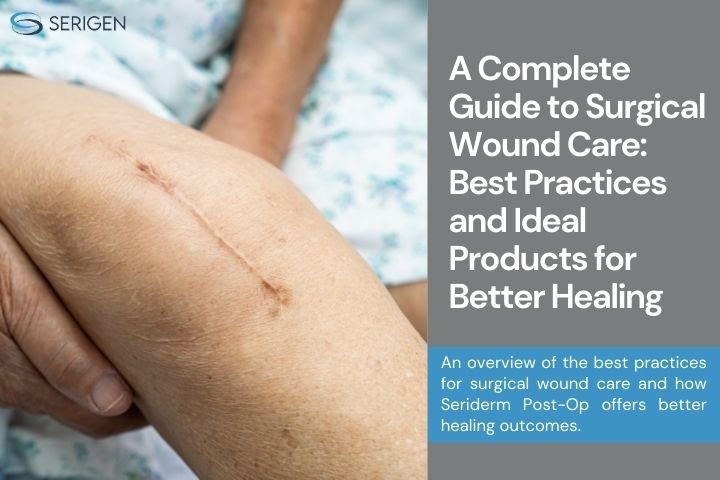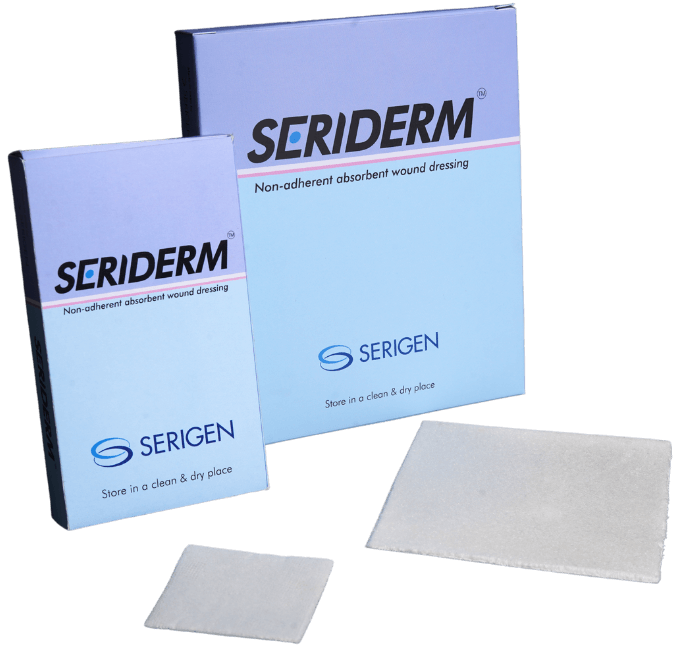A Complete Guide to Surgical Wound Care: Best Practices and Ideal Products for Better Healing

Introduction
Surgical wound care is more than just a part of recovery; it’s a vital step toward faster healing, reduced infection risks, and better long-term outcomes. Whether you’ve undergone a minor outpatient procedure or a major operation, properly caring for your surgical wound can significantly impact your healing process.
This guide is designed for post-operative patients, caregivers, and clinicians looking for practical, evidence-based advice on surgical wound care after various types of surgeries, including orthopedic, oncological, plastic, cardiac, and other surgeries. It further explores how Serigen’s advanced wound dressing, Seriderm Post-Op, serves as an ideal dressing for surgical wounds.
Understanding Surgical Wounds
What Is a Surgical Wound?
A surgical wound is an intentional incision made through the skin during a medical procedure. Unlike accidental injuries, surgical wounds are typically cleaner and made under sterile conditions, but they still require diligent care.
Types of Surgical Wounds
Surgical wounds are classified into four main categories based on the level of contamination and infection risk.
This classification helps guide treatment decisions and infection control strategies.
-
Clean Wounds
These are planned surgical incisions made under strict sterile conditions without entry into any contaminated body system (e.g. respiratory, gastrointestinal, or urinary tracts). No infection is present.
Examples: Closed hernia repair, orthopedic surgeries, or other elective procedures with no contamination.
-
Clean-Contaminated Wounds
These wounds involve controlled access to colonized systems, such as the respiratory, gastrointestinal, or urinary tracts. Although performed under sterile conditions, these surgeries carry a moderate risk of microbial contamination due to the nature of the organs involved.
Examples: Appendectomy, bowel resection without spillage, or urological surgeries.
-
Contaminated Wounds
This category includes traumatic wounds, surgeries with significant breaches in sterile technique, or procedures involving spillage from internal organs. These wounds present a high risk of infection and demand close observation and timely intervention.
Examples: Open accidental injuries, emergency abdominal surgeries with bowel leakage.
-
Dirty or Infected Wounds
These wounds are associated with pre-existing infection, abscesses, or perforated internal organs. They carry the highest risk of complications, often requiring aggressive wound care, possible debridement, and systemic therapy.
Examples: Surgery for perforated bowel, infected traumatic wounds.
How Long Does a Surgical Wound Take to Heal?
Healing times for surgical wounds vary. Most superficial surgical wounds heal within 6–8 weeks, but deeper or more complex wounds may take longer. Recovery is influenced by your overall health, type of surgery, and how well the wound is cared for.
Surgical Wound Healing Process
Stages of Healing
-
- Hemostasis: Clotting stops the bleeding.
- Inflammation: White blood cells fight infection.
- Proliferation: New tissue and blood vessels form.
- Maturation: Collagen remodeling strengthens the tissue.
Factors That Influence Surgical Wound Healing Time
- Age and overall health
- Nutritional status
- Smoking or alcohol use
- Type and location of surgery
- Infection or complications
Signs Your Surgical Wound Is Healing Normally
- Mild redness or swelling that decreases over time
- Minimal discharge
- Scab formation
- Gradual reduction in pain
Watch out for trouble: Increased redness, pus, excessive swelling, worsening pain, or a foul odor may signal infection.
Dressing a Surgical Wound
What Is a Surgical Wound Dressing?
A surgical wound dressing protects the wound from infection, maintains moisture, and supports healing. It can be as simple as gauze or as advanced as hydrocolloid or silk base dressing or silicone-based materials.
Types of Surgical Wound Dressings
Choosing the right surgical wound dressing is essential for optimal healing. Below are some surgical wound dressing types and their uses:
- Gauze Dressings: Suitable for simple, dry wounds; easy to apply and commonly used.
- Foam Dressings: Highly absorbent, ideal for wounds with moderate to heavy exudate.
- Hydrocolloid Dressings: Promote healing by maintaining a moist environment and protecting the wound.
- Waterproof Surgical Wound Dressings: Shield the wound from water during bathing or showering.
- Silicone Dressings: Gentle and non-adherent, ideal for sensitive or fragile skin; minimize pain during dressing changes.
- Silk-Based Surgical Wound Dressings: Designed to be soft, breathable, and conformable, silk dressings offer skin-friendly protection and are often used on delicate or post-surgical skin to reduce irritation and support healing.
Always consult your healthcare provider to choose the most appropriate dressing for your specific wound type and healing stage.
Surgeries That Commonly Require Post-Operative Dressings:
Here are common surgical areas where advanced post-op dressings like Seriderm Post-Op play a vital role:
Oncology
Procedures like mastectomy, lumpectomy, and tumor or lymph node removal require gentle, breathable dressings that minimize trauma to sensitive areas.
Orthopedics
Osteotomies, joint replacements, and fracture repairs need conformable, secure dressings that support mobility and protect deep tissue from infection.
Cardiology
Bypass grafts, pacemaker implants, and valve surgeries benefit from dressings that manage exudate and allow wound visibility—making Seriderm’s design ideal.
Gynecology
Hysterectomies, C-sections, and laparoscopic procedures require skin-friendly, low-irritation dressings with reliable adhesion.
Other Surgeries
General, plastic, reconstructive, and dermatologic procedures also benefit from versatile solutions like Seriderm for comfort, protection, and efficient healing.
Cleaning a Surgical Wound: A Step-by-Step Guide
How to Clean a Surgical Wound with Stitches Safely:
Cleaning a surgical wound with stitches helps prevent infection and supports healing. The process may vary slightly depending on whether you’re in a home or clinical setting, but the principles remain the same.
Basic Steps:
Wash your hands thoroughly with soap and water (or use gloves in a clinical setup).
Prepare clean, sterile materials tray, including:
- Sterile gauze or cotton pads
- Normal saline (0.9% sodium chloride) or antiseptic solution if prescribed
- Clean gloves (optional at home, mandatory in clinics)
Gently clean around the stitches:
- Pour saline over the wound or soak the gauze in it.
- Wipe from the center of the wound outward to avoid bringing contaminants in.
- Avoid rubbing or putting pressure on the stitches.
Pat dry with a fresh piece of sterile gauze.
Apply an ointment if advised by your doctor.
Redress the wound with a fresh, sterile dressing
Important Tips:
- Don’t use hydrogen peroxide or alcohol unless instructed, as they can delay healing.
- If the wound looks red, swollen, or leaks pus, contact your healthcare provider.
General Surgical Wound Cleaning Steps:
Clean your surgical wound once or twice daily, or as directed by your healthcare provider. Use sterile saline or the recommended cleaning solution. Avoid alcohol or hydrogen peroxide unless specifically advised, as they can damage healing tissue.
While cleaning, check for signs of infection—redness, swelling, pus, or foul odor. Prompt attention to any changes can help prevent complications
When and How to Change Surgical Wound Dressings
Properly changing your surgical dressing is essential for preventing infection and promoting healthy healing. Consistent, correct care plays a major role in your recovery.
How Often Should Surgical Wound Dressings Be Changed?
Dressings are typically changed once a day—or sooner if they become wet, soiled, or loose. Follow your healthcare provider’s specific instructions, which may vary based on wound type, drainage, and healing progress.
When to Stop Packing a Wound
Stop packing when:
- There’s minimal drainage.
- The wound cavity has filled in.
- Your healthcare provider advises it.
Recognizing Surgical Wound Infection Early
Identifying signs of infection early is crucial for preventing complications and promoting recovery. Here’s what to watch for and when to seek medical help.
Warning Signs of Surgical Wound Infection
Be alert for the following symptoms around your surgical wound:
- Redness that spreads or becomes more intense
- Pus or yellow-green discharge from the wound
- Increased swelling, warmth, or pain
- Fever or chills, especially above 100.4°F (38°C)
- A foul odor coming from the wound site
These may indicate that the wound is no longer healing properly and that an infection is developing.
When to Call Your Doctor
Contact your healthcare provider promptly if you notice:
- Any of the signs of infection listed above
- Wound edges pulling apart or stitches coming loose
- A fever over 100.4°F (38°C) or feeling unwell
Prompt medical attention can prevent more serious complications and may reduce the need for antibiotics or further procedures.
Can an Infected Wound Still Heal?
Yes. With early and appropriate treatment, most infected surgical wounds can still heal well. The key is to act quickly – delaying care increases the risk of further tissue damage or systemic infection.
Seriderm Ag Post-Op is an advanced surgical wound dressing especially designed for high-risk or infected wounds. It offers the sustained antimicrobial action of Silver ions to support the healing of infection-prone surgical wounds.
Best Products for Wound Care
Choosing the right products can significantly improve healing outcomes after surgery. The focus should be on maintaining moisture balance, protecting the wound, and supporting natural tissue regeneration.
Topical Options for Wound Healing
- Moisture-enhancing gels: Help create a balanced environment that supports cell repair and faster healing.
- Regenerative creams: Often recommended by clinicians, these creams are formulated to promote collagen production and tissue regeneration.
Benefits of advanced wound dressings like Seriderm Post-Op
Advanced Dressings: The Seriderm Advantage
Seriderm Post-Op by Serigen is a next-generation wound dressing powered by 100% silk proteins in wound contact layer, designed to accelerate surgical wound healing through multiple advanced features:
- Supports tissue regeneration by enhancing re-epithelialization, collagen formation, and angiogenesis resulting in scar-free healing
- Reduces inflammation and oxidative stress at the wound site
- Maintains optimal moisture with appropriate porosity and controlled MVTR (300–1000 g/m²/24hr)
- Non-adherent design allows painless removal without disrupting healing tissue
- Barrier protection against microbes and contaminants with a non-permeable conformable layer
- Biocompatible & safe (ISO 10993): non-toxic, non-irritant, and suitable for long-term use
- Painless application and removal; Useful for pediatric, geriatric and periwound delicate skin
- Breathable and waterproof
- Stays on for up to a week
This unique combination of silk and engineered design creates an ideal environment for faster, safer, and reliable wound healing, trusted by clinicians and ideal for patients.
FAQs
Should Surgical Wounds Be Covered or Exposed?
Most surgical wounds heal better when covered, especially in the early stages.
Can I Shower with Waterproof Dressing?
Yes, waterproof surgical wound dressings like Seriderm Post-Op are designed to allow showering while protecting the wound.
How Long to Keep the Wound Dressed?
Usually for 5–7 days or until your healthcare provider advises otherwise.
What If the Stitches Look Infected?
Contact your doctor immediately. Do not try to remove or treat stitches on your own
Conclusion
Caring for a surgical wound is essential to promote proper healing, prevent infection, and ensure the best outcome after surgery. Follow your doctor’s instructions closely, use appropriate post-op wound dressings and cleaning techniques, and don’t hesitate to seek medical advice if something doesn’t seem right.
At Serigen, we are committed to advancing regenerative wound healing through innovative products like Seriderm Post-Op. Our mission is to help you heal faster, safer, and more comfortably. Explore our range of advanced silk-based wound dressings today to jumpstart your healing with Seriderm.
References
-
Cleveland Clinic. (n.d.). Incision care. Cleveland Clinic. https://my.clevelandclinic.org/health/treatments/15709-incision-care
-
MedlinePlus. (n.d.). Surgical wound infection. U.S. National Library of Medicine. https://medlineplus.gov/ency/article/007645.htm
-
MedlinePlus. (n.d.). Surgical wound care – open and closed; How wounds heal. U.S. National Library of Medicine. https://medlineplus.gov/ency/article/007645.htm
-
Royal Children’s Hospital Melbourne. (n.d.). Wound assessment and management. The Royal Children’s Hospital. https://www.rch.org.au/rchcpg/hospital_clinical_guideline_index/Wound_assessment_and_management
-
RACGP. (2013). Post-operative wound management. Australian Family Physician, 42(12). https://www.racgp.org.au/afp/2013/december/post-operative-wound-management
-
Verywell Health. (n.d.). How to care for a surgical incision. Verywell Health. https://www.verywellhealth.com/how-to-care-for-a-surgical-incision-3156925
-
WebMD. (n.d.). Surgical wound care. WebMD. https://www.webmd.com/first-aid/surgical-wound-care
-
Wound Care Resource / Clinical & Wound Knowledge (CLWK). (n.d.). Surgical wounds: Incision and surgical dehiscence guideline. CLWK. https://www.clwk.ca/get-resource/surgical-wounds-incision-surgical-dehiscence-guideline

Introduction
Surgical wound care is more than just a part of recovery; it’s a vital step toward faster healing, reduced infection risks, and better long-term outcomes. Whether you’ve undergone a minor outpatient procedure or a major operation, properly caring for your surgical wound can significantly impact your healing process.
This guide is designed for post-operative patients, caregivers, and clinicians looking for practical, evidence-based advice on surgical wound care after various types of surgeries, including orthopedic, oncological, plastic, cardiac, and other surgeries. It further explores how Serigen’s advanced wound dressing, Seriderm Post-Op, serves as an ideal dressing for surgical wounds.
Understanding Surgical Wounds
What Is a Surgical Wound?
A surgical wound is an intentional incision made through the skin during a medical procedure. Unlike accidental injuries, surgical wounds are typically cleaner and made under sterile conditions, but they still require diligent care.
Types of Surgical Wounds
Surgical wounds are classified into four main categories based on the level of contamination and infection risk.
This classification helps guide treatment decisions and infection control strategies.
-
Clean Wounds
These are planned surgical incisions made under strict sterile conditions without entry into any contaminated body system (e.g. respiratory, gastrointestinal, or urinary tracts). No infection is present.
Examples: Closed hernia repair, orthopedic surgeries, or other elective procedures with no contamination.
-
Clean-Contaminated Wounds
These wounds involve controlled access to colonized systems, such as the respiratory, gastrointestinal, or urinary tracts. Although performed under sterile conditions, these surgeries carry a moderate risk of microbial contamination due to the nature of the organs involved.
Examples: Appendectomy, bowel resection without spillage, or urological surgeries.
-
Contaminated Wounds
This category includes traumatic wounds, surgeries with significant breaches in sterile technique, or procedures involving spillage from internal organs. These wounds present a high risk of infection and demand close observation and timely intervention.
Examples: Open accidental injuries, emergency abdominal surgeries with bowel leakage.
-
Dirty or Infected Wounds
These wounds are associated with pre-existing infection, abscesses, or perforated internal organs. They carry the highest risk of complications, often requiring aggressive wound care, possible debridement, and systemic therapy.
Examples: Surgery for perforated bowel, infected traumatic wounds.
How Long Does a Surgical Wound Take to Heal?
Healing times for surgical wounds vary. Most superficial surgical wounds heal within 6–8 weeks, but deeper or more complex wounds may take longer. Recovery is influenced by your overall health, type of surgery, and how well the wound is cared for.
Surgical Wound Healing Process
Stages of Healing
-
- Hemostasis: Clotting stops the bleeding.
- Inflammation: White blood cells fight infection.
- Proliferation: New tissue and blood vessels form.
- Maturation: Collagen remodeling strengthens the tissue.
Factors That Influence Surgical Wound Healing Time
- Age and overall health
- Nutritional status
- Smoking or alcohol use
- Type and location of surgery
- Infection or complications
Signs Your Surgical Wound Is Healing Normally
- Mild redness or swelling that decreases over time
- Minimal discharge
- Scab formation
- Gradual reduction in pain
Watch out for trouble: Increased redness, pus, excessive swelling, worsening pain, or a foul odor may signal infection.
Dressing a Surgical Wound
What Is a Surgical Wound Dressing?
A surgical wound dressing protects the wound from infection, maintains moisture, and supports healing. It can be as simple as gauze or as advanced as hydrocolloid or silk base dressing or silicone-based materials.
Types of Surgical Wound Dressings
Choosing the right surgical wound dressing is essential for optimal healing. Below are some surgical wound dressing types and their uses:
- Gauze Dressings: Suitable for simple, dry wounds; easy to apply and commonly used.
- Foam Dressings: Highly absorbent, ideal for wounds with moderate to heavy exudate.
- Hydrocolloid Dressings: Promote healing by maintaining a moist environment and protecting the wound.
- Waterproof Surgical Wound Dressings: Shield the wound from water during bathing or showering.
- Silicone Dressings: Gentle and non-adherent, ideal for sensitive or fragile skin; minimize pain during dressing changes.
- Silk-Based Surgical Wound Dressings: Designed to be soft, breathable, and conformable, silk dressings offer skin-friendly protection and are often used on delicate or post-surgical skin to reduce irritation and support healing.
Always consult your healthcare provider to choose the most appropriate dressing for your specific wound type and healing stage.
Surgeries That Commonly Require Post-Operative Dressings:
Here are common surgical areas where advanced post-op dressings like Seriderm Post-Op play a vital role:
Oncology
Procedures like mastectomy, lumpectomy, and tumor or lymph node removal require gentle, breathable dressings that minimize trauma to sensitive areas.
Orthopedics
Osteotomies, joint replacements, and fracture repairs need conformable, secure dressings that support mobility and protect deep tissue from infection.
Cardiology
Bypass grafts, pacemaker implants, and valve surgeries benefit from dressings that manage exudate and allow wound visibility—making Seriderm’s design ideal.
Gynecology
Hysterectomies, C-sections, and laparoscopic procedures require skin-friendly, low-irritation dressings with reliable adhesion.
Other Surgeries
General, plastic, reconstructive, and dermatologic procedures also benefit from versatile solutions like Seriderm for comfort, protection, and efficient healing.
Cleaning a Surgical Wound: A Step-by-Step Guide
How to Clean a Surgical Wound with Stitches Safely :
Cleaning a surgical wound with stitches helps prevent infection and supports healing. The process may vary slightly depending on whether you’re in a home or clinical setting, but the principles remain the same.
Basic Steps:
Wash your hands thoroughly with soap and water (or use gloves in a clinical setup).
Prepare clean, sterile materials tray, including:
- Sterile gauze or cotton pads
- Normal saline (0.9% sodium chloride) or antiseptic solution if prescribed
- Clean gloves (optional at home, mandatory in clinics)
Gently clean around the stitches:
- Pour saline over the wound or soak the gauze in it.
- Wipe from the center of the wound outward to avoid bringing contaminants in.
- Avoid rubbing or putting pressure on the stitches.
Pat dry with a fresh piece of sterile gauze.
Apply an ointment if advised by your doctor.
Redress the wound with a fresh, sterile dressing
Important Tips:
- Don’t use hydrogen peroxide or alcohol unless instructed, as they can delay healing.
- If the wound looks red, swollen, or leaks pus, contact your healthcare provider.
General Surgical Wound Cleaning Steps:
Clean your surgical wound once or twice daily, or as directed by your healthcare provider. Use sterile saline or the recommended cleaning solution. Avoid alcohol or hydrogen peroxide unless specifically advised, as they can damage healing tissue.
While cleaning, check for signs of infection—redness, swelling, pus, or foul odor. Prompt attention to any changes can help prevent complications
When and How to Change Surgical Wound Dressings
Properly changing your surgical dressing is essential for preventing infection and promoting healthy healing. Consistent, correct care plays a major role in your recovery.
How Often Should Surgical Wound Dressings Be Changed?
Dressings are typically changed once a day—or sooner if they become wet, soiled, or loose. Follow your healthcare provider’s specific instructions, which may vary based on wound type, drainage, and healing progress.
When to Stop Packing a Wound
Stop packing when:
- There’s minimal drainage.
- The wound cavity has filled in.
- Your healthcare provider advises it.
Recognizing Surgical Wound Infection Early
Identifying signs of infection early is crucial for preventing complications and promoting recovery. Here’s what to watch for and when to seek medical help.
Warning Signs of Surgical Wound Infection
Be alert for the following symptoms around your surgical wound:
- Redness that spreads or becomes more intense
- Pus or yellow-green discharge from the wound
- Increased swelling, warmth, or pain
- Fever or chills, especially above 100.4°F (38°C)
- A foul odor coming from the wound site
These may indicate that the wound is no longer healing properly and that an infection is developing.
When to Call Your Doctor
Contact your healthcare provider promptly if you notice:
- Any of the signs of infection listed above
- Wound edges pulling apart or stitches coming loose
- A fever over 100.4°F (38°C) or feeling unwell
Prompt medical attention can prevent more serious complications and may reduce the need for antibiotics or further procedures.
Can an Infected Wound Still Heal?
Yes. With early and appropriate treatment, most infected surgical wounds can still heal well. The key is to act quickly – delaying care increases the risk of further tissue damage or systemic infection.
Seriderm Ag Post-Op is an advanced surgical wound dressing especially designed for high-risk or infected wounds. It offers the sustained antimicrobial action of Silver ions to support the healing of infection-prone surgical wounds.
Best Products for Wound Care
Choosing the right products can significantly improve healing outcomes after surgery. The focus should be on maintaining moisture balance, protecting the wound, and supporting natural tissue regeneration.
Topical Options for Wound Healing
- Moisture-enhancing gels: Help create a balanced environment that supports cell repair and faster healing.
- Regenerative creams: Often recommended by clinicians, these creams are formulated to promote collagen production and tissue regeneration.
Benefits of advanced wound dressings like Seriderm Post-Op
Advanced Dressings: The Seriderm Advantage
Seriderm Post-Op by Serigen is a next-generation wound dressing powered by 100% silk proteins in wound contact layer, designed to accelerate surgical wound healing through multiple advanced features:
- Supports tissue regeneration by enhancing re-epithelialization, collagen formation, and angiogenesis resulting in scar-free healing
- Reduces inflammation and oxidative stress at the wound site
- Maintains optimal moisture with appropriate porosity and controlled MVTR (300–1000 g/m²/24hr)
- Non-adherent design allows painless removal without disrupting healing tissue
- Barrier protection against microbes and contaminants with a non-permeable conformable layer
- Biocompatible & safe (ISO 10993): non-toxic, non-irritant, and suitable for long-term use
- Painless application and removal; Useful for pediatric, geriatric and periwound delicate skin
- Breathable and waterproof
- Stays on for up to a week
This unique combination of silk and engineered design creates an ideal environment for faster, safer, and reliable wound healing, trusted by clinicians and ideal for patients.
FAQs
Should Surgical Wounds Be Covered or Exposed?
Most surgical wounds heal better when covered, especially in the early stages.
Can I Shower with Waterproof Dressing?
Yes, waterproof surgical wound dressings like Seriderm Post-Op are designed to allow showering while protecting the wound.
How Long to Keep the Wound Dressed?
Usually for 5–7 days or until your healthcare provider advises otherwise.
What If the Stitches Look Infected?
Contact your doctor immediately. Do not try to remove or treat stitches on your own
Conclusion
Caring for a surgical wound is essential to promote proper healing, prevent infection, and ensure the best outcome after surgery. Follow your doctor’s instructions closely, use appropriate post-op wound dressings and cleaning techniques, and don’t hesitate to seek medical advice if something doesn’t seem right.
At Serigen, we are committed to advancing regenerative wound healing through innovative products like Seriderm Post-Op. Our mission is to help you heal faster, safer, and more comfortably. Explore our range of advanced silk-based wound dressings today to jumpstart your healing with Seriderm.
References
-
Cleveland Clinic. (n.d.). Incision care. Cleveland Clinic. https://my.clevelandclinic.org/health/treatments/15709-incision-care
-
MedlinePlus. (n.d.). Surgical wound infection. U.S. National Library of Medicine. https://medlineplus.gov/ency/article/007645.htm
-
MedlinePlus. (n.d.). Surgical wound care – open and closed; How wounds heal. U.S. National Library of Medicine. https://medlineplus.gov/ency/article/007645.htm
-
Royal Children’s Hospital Melbourne. (n.d.). Wound assessment and management. The Royal Children’s Hospital. https://www.rch.org.au/rchcpg/hospital_clinical_guideline_index/Wound_assessment_and_management
-
RACGP. (2013). Post-operative wound management. Australian Family Physician, 42(12). https://www.racgp.org.au/afp/2013/december/post-operative-wound-management
-
Verywell Health. (n.d.). How to care for a surgical incision. Verywell Health. https://www.verywellhealth.com/how-to-care-for-a-surgical-incision-3156925
-
WebMD. (n.d.). Surgical wound care. WebMD. https://www.webmd.com/first-aid/surgical-wound-care
-
Wound Care Resource / Clinical & Wound Knowledge (CLWK). (n.d.). Surgical wounds: Incision and surgical dehiscence guideline. CLWK. https://www.clwk.ca/get-resource/surgical-wounds-incision-surgical-dehiscence-guideline
Author Bio – Keiretliu Chawang, a Registered Nurse, serves as a clinical educator at Serigen Mediproducts. She earned her nursing degree from the Nightingale Nursing Institute and brings 16 years of professional clinical experience across various specialties.












